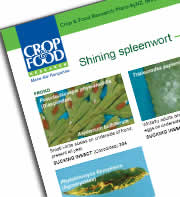|
Reliability score
What is the reliability score?
The information to support a particular invertebrate herbivores
association with a particular plant varies in quality and therefore
reliability.
In the best case there is excellent evidence that the herbivore
successfully breeds on the plant. In the worst case an adult has
been found sitting on a plant leaf with no evidence of feeding,
rather like finding a beetle resting on washing hanging on the
line. The presence of the beetle on washing is not evidence for
feeding or breeding.
In the Plant-SyNZ database a reliability score of 0 to 10 is used,
with 10 being high quality evidence supporting a herbivore-host
plant association. 0 is used for published associations that are
subsequently shown to be wrong. The database also gives the reason/evidence
for the score, who gave the score and the date when it was given. The
score is subjective and is based on expert interpretation of each
relationship (see below for details). Care needs to be used when
interpreting the reliability score.
The Plant-SyNZ database does not provide information on the relative
suitability of host plant species for a herbivore. See "What
is a host plant?" for a discussion of host plants.
How to use the reliability score
When generating a report from the database, you can select for
the quality of host associations that you require. You can choose
to have all the host associations for a selected plant or herbivore
species, or you can choose to have only host associations with
a minimum score i.e. 5 and above or 7 and above.
Reports with and without reasons for
the scores
All the reports from the database will show
the reliability score. However, you can choose whether or not
to have the reasons for the score. This option "without reasons"
allows for more compact reports, the option "with reasons" allows
the user to understand why a score was given and to better decide
how to filter the lists using the reliability score.
What criteria are used for reliability scores?
The
criteria that can be used for reliability scores varies according
to the biology of each group of herbivores. For example, juvenile whitefly stay
on the leaf on which the egg is laid, and are identified from the
puparium. The presence of whitefly puparia on a plant is excellent
evidence that the plant species is a host and the association is
given a score of 10. If the plant can only be identified to genus,
the score is reduced to 7. Similarly other scale insects that
stay on the same plant for all their life stages would score 10
if the adult female is found on a plant species.
Insects and mites with more mobile adult and juvenile stages need
more judicious consideration.
Mites, especially those associated with galls
need careful observation and good evidence of breeding on the plant
to be certain of a host association. Where a gall is involved,
the best evidence is from breeding mites found in the newly formed
gall. Once a gall has matured, it may be invaded by other invertebrates,
including other gall mites that then use it as a shelter, but do
not necessarily breed on the plant.
Caterpillars ideally should be found on the suspected
host plant and reared on it to maturity and the moth identified.
Care needs to be taken when large, almost mature caterpillars are
found on a plant; the plant may not be a primary host. Some large
caterpillars can feed on plants that do not support the growth
of all stages of the species.
Leaf feeding beetles. Some beetles such as Chrysomelidae
and some weevils have adults that feed on leaves, but the larvae
have different or unknown habits. Adults may be found on a plant
with typical feeding damage for that kind of beetle. However, it
is advisable to check that the beetle does feed on the plant by
putting the adult beetles in a container such as a plastic bag
or lidded jar with undamaged leaves. If after a day the leaves
exhibit feeding damage of the kind seen on the host plant, then
this can be regarded as good evidence for a host association and
not a chance occurrence on the plant..
Gall forming insects and leaf miners need to
be reared to identify the insect and hence the host association.
In some cases a distinctive gall or mine may be found on another
plant species in the same genus and a tentative host association
created with a score of 5 or 6 depending upon the circumstances.
Aphids. The presence of wingless females or winged
forms with colonies can provide good evidence for a host association.
Thrips and mobile sucking bugs. The presence
of adults and juvenile stages of the same species is good evidence
of a host association, though it is possible the species may be
partially or wholly predacious. It is important that, where possible,
the juveniles are reared to maturity on part of the plant. Juveniles
in the absence of adults should, of course, be reared to maturity.
Contacts/Feedback
 |
PDFs can be viewed
using Adobe Reader. |
|


